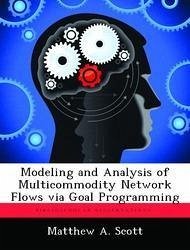Information superiority, along with air superiority, must be achieved and maintained in a theatre of battle in order to increase efficacy and provide protection to our forces, both on the ground and in the air. Information, for the most part, utilizes an underlying network that is identified, and is of vital interest to a commander in a wartime or peacetime scenario. This underlying network must be modeled and analyzed in order to develop target prioritization and to analyze effects of target prioritization implementation. In this work goal programming is used to solve a minimum cost multicommodity network flow problem with multiple objectives. The networks to be analyzed are telecommunication networks, specifically, a single telecommunication network with multiple commodities (e.g., voice, video, data, etc.) flowing over it. This network consists of: linear objective function, linear cost arcs, fixed capacities, specific origin-destination pairs for each commodity. A minimum cost multicommodity network flow problem with multiple objectives can be successfully modeled using linear goal programming techniques. When properly modeled, network flow techniques may still be employed to exploit the pure network structure of a minimum cost multicommodity network flow problem with multiple objectives.








